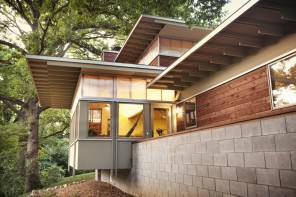As a result of the global recession, funding for artistic projects, communities, and individuals is being cut. Rather than killing the creative spirit, however, these cuts seem to be spawning creativity in ways to save money in artful ways. For example, a recent post at The Guardian Theatre Blog highlights several innovative approaches to building theatres that make financial sense and make art. One of these projects is The Jellyfish Theatre, described on their website as “an eye-opening new venue made entirely from recycled and reclaimed materials.” The Guardian article claims that this will be the first ever theatre venue constructed from 100% recycled and reclaimed material. Now that’s an accomplishment! Here’s a digital projection of what the theatre will look like. Unfortunately, shows will only run in this theatre for a little over two months before it will be dismantled.
Some theatre companies are abandoning theatre buildings completely and getting creative by performing in abandoned building or public spaces, although this is not an entirely new development. Performing in the streets and other public places has a long history in theatre. A more permanent example is the Waterloo East Theatre that is soon to open in Lambeth. Because the designer has no funding, grants, or loans, he is making do with recycled materials and hopes that besides being an example of artistic creativity within constraints, it will be a beacon of environmental awareness.
What can Christian churches learn from these developments and initiatives in theatre? Should Christians be thinking more creatively about the places where they meet for worship? Should millions of dollars really be used to construct impressive and elaborate church buildings? Interestingly enough, if you google “innovative church spaces” or “innovative church buildings,” most of the top results include companies that build massive churches or individuals highlighting enormous church complexes constructed to be a one-stop shop for your every spiritual need.
What I would love to see is churches thinking creatively and with innovation about worship spaces that do not cost millions so that those millions can be spent caring for people’s needs. I know this is a controversial point, but perhaps it would be less controversial if by more cost effective we did not mean ugly. All too often building a cost-effective church means meeting in a white-washed cardboard box of some kind with gray folding chairs and a scribbled Jesus banner hanging up front. What I imagine instead is a community of people using their creative abilities to create a beautiful, engaging space while aiming to save costs and focus on how the church space contributes to God’s mission to the world. When my wife and I spent a year working with Armonía Ministries in Mexico, one of their practices was to design and build their community spaces with donated material and in a way that would serve the community’s needs. Because of this, the community would take ownership of the building and pool together their creativity and artistic talents to make the space not just functional, but beautiful. The building materials were corrugated metal and concrete, but the result was something meaningful and beautiful like the painting pictured on the left.
Can you think of other examples where Christians communities have constructed innovative worship and meeting spaces, and by innovative meaning both cost-effective and beautiful? Do you think the churches should be even more radical and not have their own buildings at all, but simply meet in rented spaces in order to save money? Of course, sometimes this is inevitable, but what are the advantages or disadvantages to this perspective?






Wes, thanks for this!
I was part of a church in Canberra, Australia that did not have a building – rather each congregation met in a local school hall or university lecture theatre. It took me a while to get used to thinking of a lecture theatre where i listened to world war one history during the week as a sacred space. It certainly pushed me out of my comfort zone. but what i came to love about the meeting places of this church is that the focus was on the body of Christ, on the people and that we had great flexibility (in so far as a building or space was available) to adapt to the changing needs of the church community.
Having your own building and complex certainly can save alot of hassles and give you storage space and purpose built facilities, but the flexible approach and working with what’s available -whether that’s recycled materials or local community facilities – has a certain beauty to it.
Thanks for relating your own experience, Anna. I guess here in the UK there is the opposite problem, that is, churches are dying and church buildings are being abandoned rather than built. What do small communities of Christians do, however, when they occupy an enormous church building that takes more money for upkeep than the congregation can muster? Would one creative response to this situation be churches banding together to maintain these spaces for worship and other events? I am drawn to this idea, especially because of the ecumenical import this kind of effort could affect.
But if historic church building are not available, I think you are right that being flexible what IS available can have beauty and helps keep our focus on participating in the mission of God.
In contrast to a lot of churches in the area, St. Andrews Baptist cannot fit in its sanctuary for the morning service, at least during the school year (now that it’s summer we might be able to). For that reason our morning services are held at the Kilrymont campus of Madras College. The space there works decently well, though the artwork the school has decorating the walls is a bit incongruous, and the space is not as focused as I would like–though it might be possible to create a more focused space.
As an undergraduate in the USA, I also attended a church that met in a school, in their case because they had not yet built their own building. They experimented with different configurations and rooms, and eventually moved to a different school, before they finally completed a building toward the end of my time there. Interestingly, the finished sanctuary had chairs rather than pews, a platform for pulpit, choir, etc. that could be disassembled, and an AWANA game circle made into the carpet so that the sanctuary could be used for games during AWANA meetings.
They were definitely not concerned with creating a permanent sacred space, and definitely were concerned about cost-effective use of space. I am still conflicted on this issue, because I have experienced advantages and drawbacks to rented spaces, multipurpose spaces in the church, and dedicated sanctuaries. I don’t have any answers yet, except that I think people should always find a way to make their worship space focused to encourage people to leave aside distractions and pay attention to the preaching, Eucharist, or baptism, whichever one ought to be emphasized most (which is another issue).
While I like the idea, in theory, of churches spending less money on their buildings (by using what they have at hand, or by using less expensive materials) so they can spend more money on other aspects of their mission, I wonder whether, in the long run, this is the best approach. Specifically, I am thinking that inexpensive materials (even inexpensive materials used creatively and resourcefully) may lead to a building that will fall apart faster. A church building that is not well built (good materials, good craftsmanship) will probably not last as long as one that is. So, I wonder if one considers ‘cost-effectiveness’ from a very long perspective (say, 100 years) whether it isn’t better to pay a lot of money up front for something you are fairly certain will last. The reason I like this (potentially more expensive) sustainable church building is that it carries an implicit commitment to a place and to a community. Churches are less likely to go and build a new building (in a new place) if they invested a lot of resources in the one they are currently using. What do you think? Do you think it is possible to do sustainability with inexpensive materials and labor? Have you had experience working with a church on a building project, and so do you know much about the cost of different kinds of materials?
You raise some good point, Jim, and my initial reaction is that I would think it is possible to construct church buildings that are cost effective, sustainable, and beautiful. My only experience working on church projects have been in Mexico where the primary construction material is concrete. These projects were definitely both cost effective and sustainable, and the beauty was added by the creative work of individuals in the congregations.
Another factor here is whether we should build big church building that would house a lot of people. It seems to me that this is probably the biggest cost: building churches that can accommodate hundreds and even thousands of people. What if we kept our church meetings smaller and more local, and if a bigger group of Christians wanted to get together, we plan a time to meet and worship together in a conference center or some other structure?
I like your point about building smaller church buildings. I think it is important for churches to remember that a building project is as much about what we need as it is about what we value. Buiidng a large ‘megaplex’ says something about the community that the church hopes to be.
(I’m responding here to Ben’s comment because I can’t figure out how to respond with the thread)
Thanks for bringing up the issue of distraction, Ben, because I think this is one of the greatest challenges with meeting in a rented or shared space. I have also had conversations with friends who met in a gymnasium and found it not at all conducive to worship and focusing on the drama of God’s gospel. So I guess all of this needs to be taken into consideration in making decision about worship spaces. Ideally, I think that if church’s construct their own meeting and worship spaces, they should be places where the community is comfortable and welcome to come and join in activities or just hang out. I would love to see church building being the open and safe places of the neighborhood.